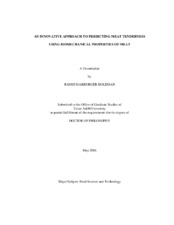| dc.description.abstract | Biomechanical compression studies at different temperatures were conducted to
correlate the biomechanical response of raw bovine Longissimus dorsi muscles varying
in USDA Quality Grade with overall sensory tenderness scores. Phase 1 assessed the
biomechanical properties of raw 2.54 cm3 samples obtained with a Texture Analyzer
fitted with a 10 cm diameter platen which applied a constant strain of 3% for four
minutes. Muscle specimens were arranged with fibers in parallel and perpendicular
orientations to the applied force and tested at 0, 2, 4, 6, 8 and 10°C. Initial stiffness,
final stiffness and energy dissipated of raw steak cubes with fiber orientation in parallel
and perpendicular fiber orientations were calculated using the models and technique of
Spadaro (1996) and correlated to overall sensory tenderness scores for each compression
temperature. All compression values had higher correlation coefficients with overall
sensory tenderness than did Warner-Bratzler Shear Force (WBSF). Of the prediction
equations developed, it was concluded that samples compressed perpendicularly at 2ºC
were better predictors of overall sensory tenderness (R2 = 0.77) than WBSF (R2 = 0.11). Phase 2 assessed the biomechanical properties of raw steaks (2.54 cm thick) using a 2
mm diameter stainless steel probe in lieu of the platen and compressing samples 0.635
cm for 0.25 sec at -6.6, 4.4 or 10°C. Initial stiffness (ISTFPR), final stiffness (FSTFPR)
and energy dissipated (EDPR) of raw intact steaks were calculated using a modification
of the models and technique of Spadaro (1996) and correlated to overall sensory
tenderness scores for each compression temperature. ISTFPR, FSTPF and EDPR values
regressed against overall sensory tenderness produced higher R-square values (R2 = 0.71
at 4.4ºC and R2 = 0.70 at 10ºC) than prediction equations using WBSF (R2 = 0.65). The
significance of this study was that sensory tenderness could be predicted rapidly and
more accurately on intact raw loin samples using a nondestructive probe measurement
than could be predicted with WBSF. This innovative technique could potentially be
used as a selection tool to ensure beef tenderness, be integrated into an on-line USDA
Quality Grading system and be utilized as a powerful non-destructive research technique. | en |


